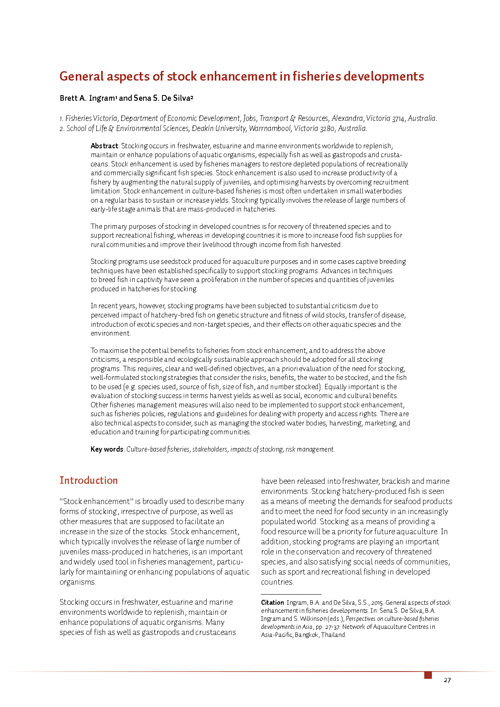General aspects of stock enhancement in fisheries developments
12 May 2015 | B.A. Ingram and Sena De Silva | 1803 Downloads | .pdf | 254.15 KB | Culture-based fisheries, Stock enhancement
Stocking occurs in freshwater, estuarine and marine environments worldwide to replenish, maintain or enhance populations of aquatic organisms, especially fish as well as gastropods and crustaceans. Stock enhancement is used by fisheries managers to restore depleted populations of recreationally and commercially significant fish species. Stock enhancement is also used to increase productivity of a fishery by augmenting the natural supply of juveniles, and optimising harvests by overcoming recruitment limitation. Stock enhancement in culture-based fisheries is most often undertaken in small water bodies on a regular basis to sustain or increase yields. Stocking typically involves the release of large numbers of early-life stage animals that are mass-produced in hatcheries.
The primary purposes of stocking in developed countries is for recovery of threatened species and to support recreational fishing, whereas in developing countries it ismore to increase food fish supplies for rural communities and improve their livelihood through income from fish harvested.
Stocking programs use seedstock produced for aquaculture purposes and in some cases captive breeding techniques have been established specifically to support stocking programs. Advances in techniques to breed fish in captivity have seen a proliferation in the number of species and quantities of juveniles produced in hatcheries for stocking.
In recent years, however, stocking programs have been subjected to substantial criticism due to perceived impact of hatchery-bred fish on genetic structure and fitness of wild stocks, transfer of disease, introduction of exotic species and non-target species, and their effects on other aquatic species and the environment.
To maximise the potential benefits to fisheries from stock enhancement, and to address the above criticisms, a responsible and ecologically sustainable approach should be adopted for all stocking programs. This requires, clear and well-defined objectives, an a priori evaluation of the need for stocking, well-formulated stocking strategies that consider the risks, benefits, the water to be stocked, and the fish to be used (e.g. species used, source of fish, size of fish, and number stocked). Equally important is the evaluation of stocking success in terms harvest yields as well as social, economic and cultural benefits. Other fisheries management measures will also need to be implemented to support stock enhancement, such as fisheries policies, regulations and guidelines for dealing with property and access rights. There are also technical aspects to consider, such as managing the stocked water bodies, harvesting, marketing, and education and training for participating communities.
Creative Commons Attribution.

